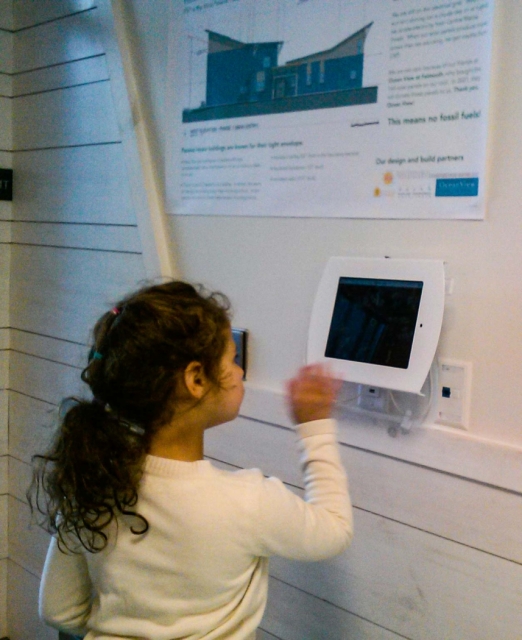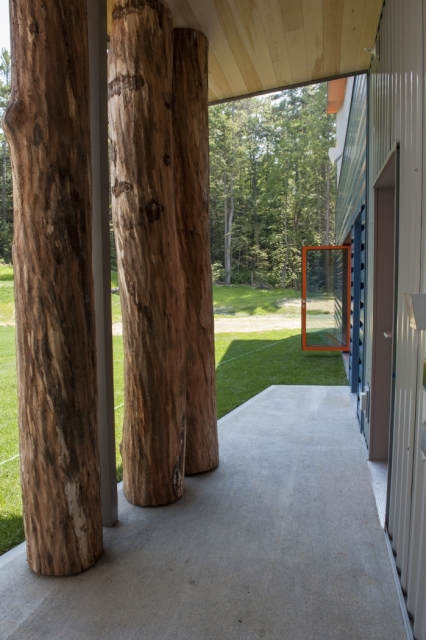Image Credit: Image #1 and #2: ncob photo
Image Credit: Image #1 and #2: ncob photo Bright colors in the school's stairwell are one feature that students have mentioned when asked what they especially like about their new school.
The 100 Maine students enrolled at the Friends School of Portland are still taking it all in, but so far seem to be enjoying life in their new 15,000-square-foot home, one of a very few Passivhaus school buildings in the country and a far cry from the leased cinderblock space they left behind.
There are bright colors, the resinous smell of pine in the air, 18 acres of woodlands to explore out back, and an iPad mounted in a hallway where students can track how much electricity the school’s solar panels are generating. (An earlier GBA article on the school was titled “In Maine, A Passivhaus School Takes Shape.”)
“It’s really an easy building to be in,” says head of school Jenny Rowe. “There’s a lot of space, there’s a lot of light. It doesn’t feel full. It’s quiet. It’s so well insulated that if a door is closed and you have people talking loudly in the hallway, the people in the classroom can’t hear anything. It just works really well.”
The Quaker day school thought it would have 90 pre-kindergarten to eighth grade students when it opened this fall. Instead, there are 100. More interest in the school, generated in part by news coverage of the construction project, has brought more people to open houses and the admissions office, Rowe said. Without commandeering space used for other programs, the school could squeeze in only two more students.

On track for net-zero energy
The $3.75 million building, designed by the Portland architectural firm Kaplan Thompson, includes a roof-mounted photovoltaic array with a rated capacity of 36 kilowatts — enough, designers hope, to generate all the electricity the school would need on an annual basis. So far, that seems to be working.
“I think we’re on track to be net-zero, according to the people we’ve been talking with at Revision Energy,” Rowe said. “But what I have learned is that net-zero is something that works itself out in the course of a year.”
Students can keep track by using an iPad that’s mounted in a hallway. Using an app called Solar-Log, they can access an energy dashboard to see how much power the solar panels have generated, by the day, month, or year, Rowe said, and get an idea of how much money the school is saving. One drawback is the dashboard doesn’t track the use of electricity, just the solar output.
Even so, it seems to be a popular spot for students, some of whom found a way to unlock the device and use it to take selfies.
“There are a lot of smudgy fingerprints on it,” Rowe says.
Low energy consumption is more than a gimmick for the school, as Rowe explained last year. With low energy costs, the school’s budget is more predictable, “pretty amazing for a small school where three kids difference in enrollment can make or break a budget,” Rowe said at the time.
Solar energy and the high-performance features of the building, however, are not part of the school’s official curriculum this year. Courses are planned on a two-year rotation, so students had some classroom instruction on solar energy last year and can look forward to it again in the future. In the meantime, Rowe said, students are encouraged to practice environmental stewardship; first and second graders responded by devising a school-wide program to compost paper towels.

What the students say they like
School administrators will like the low or nonexistent energy bills, but students are finding pleasure in simple things: colors and smells and the chance to play in one of the three fields out back, or roam the woodlands behind the school.
Rowe said she had recently been polling students about what in particular they like about the school. One of the eighth graders said it was the fresh-pine smell of the building that was most appealing, Rowe said, in contrast to less than ideal air quality in their old school. Other children remarked on the colors of different building components, including the orange stairs. “It makes them feel happy,” Rowe said.
One eighth grader was especially taken with the dual-flush toilets.
There also is the sense of being active participants in shaping their school-day worlds, unlike their experience in the space they had been leasing from the state.
“We couldn’t build anything, couldn’t paint anything, couldn’t even change a light bulb because it was a lease with the state,” she said. “Now, we can actually decide we want to work on trails, or learn how to use the woods. The first month, they wanted to pick elderberries or pull up the ferns to make beds with. So we talked about how we treat the land, and what are the rules we can agree on.”
Students at the Friends School also are likely to be more comfortable than their peers in public schools. Rowe recalled that in early September, unusually hot weather meant temperatures of 90 degrees. Some public schools in the area closed, and even at the Friends School it was too hot to go out back and eat at the picnic tables.
Inside, Rowe said, “it was just great.”
Waiting for certification
Naomi Beal, who headed the building committee and is director of PassivhausMAINE, said that the biggest challenge in construction was not the building itself but the weather. Maine had an unusually cold and snowy winter, with 100 inches or so of snow in the Portland area. It took some effort to keep the job site cleared of snow, she said, but a big push by the builder, the Warren Construction Group, kept the project on track.
“It was remarkably trouble-free, to a large degree,” Beal said.
The school is still awaiting its Passivhaus certification, but Beal said no one is expecting a problem getting it. Airtightness, for example, tested in the 0.3 air changes per hour range, roughly half of what’s allowed under the Passivhaus standard.
The building, she added, is working as it was designed to.
Richard Lo, the Kaplan Thompson project architect who managed the job, said that changes in the original design should improve the building’s performance, and even without the changes the school would have passed muster with the Passivhaus certifier, the Passive House Academy in Ireland.
“We’re all delighted with the project,” he said. “We’re delighted to have had very positive and pleasing comments from the school and the students. We’re very proud of the building.”
One detail in particular that Lo likes is the ceiling in the school’s large assembly area, finished with pine boards milled from trees on site. Some of the boards are 18 inches wide and 24 feet long, and they’re on full display.
Weekly Newsletter
Get building science and energy efficiency advice, plus special offers, in your inbox.















2 Comments
Congrats to KTA
Those of us in the New England building community have been following this project (at conferences as it developed) with interest and enthusiasm. It's great to see it up and thriving - looks great you guys!
Response to Jamie
Thanks Jamie! We hope to have some real data to share with folks as we monitor how the building performs this winter.
And for those interested in seeing it, there's a NESEA ProTour happening at the school on December 4th, so check out NESEA.org for details.
Phil
Log in or create an account to post a comment.
Sign up Log in